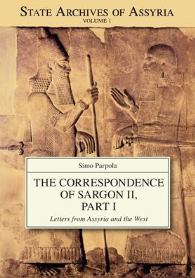
State Archives of Assyria (SAA) is a series of critical text editions of Neo-Assyrian texts, primarily those from the royal palaces at Nineveh, but also including some texts from other sites, organized by text genres. Each text is given in transliteration and English translation and is accompanied by a critical apparatus giving references to previous editions, discussions and collations of the text and a limited philological commentary. Each volume contains an introduction that briefly describes the text genre and relates it to its ancient setting, as well as computer-generated glossaries and indices to the texts. Collations of passages that differ from previous copies or readings are also given, and, if possible, hand copies of texts that have not previously been published in copy are also presented. Each volume is copiously illustrated with relevant scenes from Assyrian art or artifacts of Assyrian life.
The tablets from the royal archives at Nineveh were mostly discovered well over a century ago, in the early days of Assyriology. While most of these tablets have been published, at least in copy, these publications mostly date from the end of the 19th century or the opening decades of the 20th century. Our knowledge of Assyria and Assyrian has advanced considerably since this time, and while the previous publications were the best that could be done in their day, many better interpretations are available to us now. Furthermore, over the years many fragments from the collections have been joined with more joins continually being made as the research continues. Many of the texts have never been translated adequately, or even at all, and most have never been translated into English. Very few have been published with complete glossaries and indices of personal and geographical names.
For all these reasons, completing the publication of the State Archives of Assyria was a strong desideratum in the field of Assyrian studies, and the advent of the computer made it a real possibility. With the creation of the CNA database, the means to accomplish this were at hand. In order to complete the publication of such a large body of material within a reasonable time, the procedure was kept very simple:
The texts in the database are divided into corpora based on text genre;
If a corpus is too large to be dealt with as a whole, it is further subdivided in some meaningful way;
Each corpus or sub-corpus is assigned to an editor who is a recognized specialist in the text type;
Each editor is provided with computer-generated transliterations and indices to the corpus assigned;
The editors undertake to validate the transliterations through collation of the originals and to translate the texts into English;
Each editor is requested to provide a minimal critical apparatus and a brief introduction to the corpus;
The editors return the completed work to Helsinki where the Project staff update the database from the collations and prepare the volume for publication.
The use of this team approach means that work on a number of volumes can proceed in parallel and the availabilty of electronic mail means that manuscript, transliterations and other information can be transferred between Helsinki and the editors almost instantaneously allowing a smooth working rhythm to be maintained.

